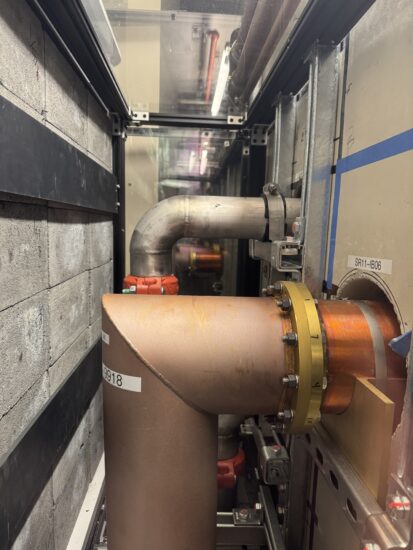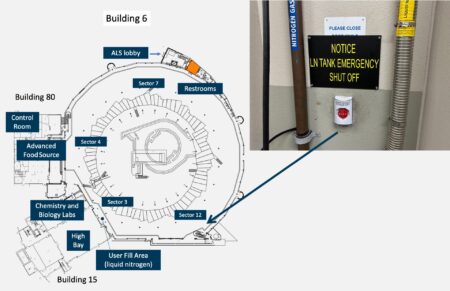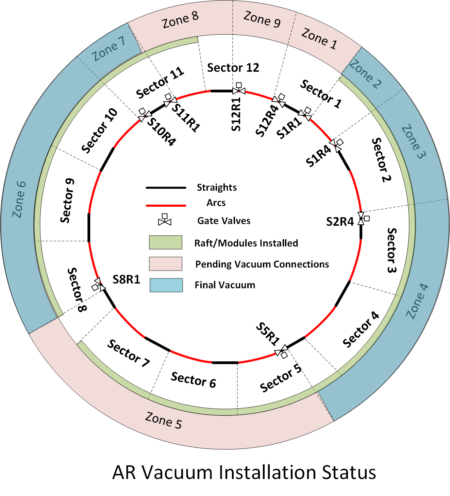by Ina Reichel
After another busy shutdown, the ALS is in the process of returning to user operation later this week. The ALS-U accomplishments from the Winter 2025 shutdown include the accumulator ring installation sectors 1–11, seismic upgrades, ALS-U cable routing and electrical installation, RF infrastructure installation, and the booster bend power supply commissioning. In addition, the teams completed several projects that improve the current ALS.
Mechanical installation of the accumulator ring
Over 90% of the accumulator ring (AR) components are now mechanically installed, and approximately half of the ring’s vacuum integration is complete, including work done during previous shutdowns. The AR has a magnetic lattice similar to that of the current storage ring, consisting of twelve arc sectors, eleven of which are now in place. The final sector is in the same area as the transfer line between the booster and storage ring, as well as future beamlines into and out of the AR. In this sector, the project team focused on installing the remaining cable routing trays, rerouting utilities that would interfere with the future AR Sector 12 installation effort, and adding seismic bracing. With these tasks complete, Sector 12 will be ready for the final AR mechanical installation push in the upcoming summer shutdown. In addition, the team did not have to disrupt the connection between the booster and storage rings, facilitating the return to user operations.
“What’s very critical in this phase of the upgrade is that we continue to operate the existing facilities,” said Daniela Leitner, Engineering Division director and the Laboratory’s chief of engineering. “Whatever my team is installing, we make sure that we minimize the impact on existing ALS operations. We work with ALS operations to make sure that the use of the facility for science operations can continue,” she stated.
RF Updates

During the winter shutdown, most of the coaxial RF lines to connect the cavities to their high-power amplifiers were installed.
“The heart of the accumulator ring RF system is the two RF cavities that were installed during the last shutdown,” said Jignya Patel, lead engineer and control account manager for the ALS-U RF systems. She explained, “To power the cavities, we have high-power RF amplifiers, which are currently being tested for acceptance and operation.”
The two amplifiers are located on top of the booster ring, requiring the coaxial RF lines to pass through the tunnel wall and up through a narrow area between the walls of the storage ring and the booster-to-storage-ring transfer line. As the lines passed through the tunnel wall, additional shielding had to be installed in that area. In addition to the coaxial RF lines and the supplemental shielding, low-conductivity water cooling pipes and cable infrastructure were also installed.
Vacuum Connections
The vacuum chambers for the magnets on the AR rafts and the dipole magnets were installed before placement in the tunnel. Once in the tunnel, all were connected, with all but two straight-section vacuum chambers installed and connected to the adjacent arc.
Sol Omolayo, ALS/ALS-U vacuum lead, shared, “65% of the AR is under final vacuum.” Once the vacuum components were connected, the connections were checked for leaks before non-evaporative getter (NEG) activation was carried out. NEG activation involves heating the NEG cartridges to 450°C for four hours and the NEG coating to 180°C for six hours. This process was successfully performed in Zones 2, 3, 4, and 6 (see AR Vacuum Installation Status graphic), where the average pressure is now 4 × 10⁻¹⁰ Torr. “This pressure satisfies the base pressure requirements for the AR vacuum,” explained Omolayo.
Booster bend power supply commissioning
Building on work from the 2024 winter and summer shutdowns, the team successfully commissioned the new booster bend power supply. This supply, located in the booster pit, not only allows the booster to ramp to 2 GeV—necessary for the newly planned ALS-U storage ring—but also replaces the 1.9-GeV power supply, which has experienced reliability issues in recent years.
“One of the greatest operational liabilities that we’ve had in recent years has been our old booster bend power supply, and the ALS-U team has installed a new booster bend power supply for us so that the new machine can reach the 2 GeV performance factor in later years,” said Steve Rossi, deputy for business operations at the Advanced Light Source. “But in the coming weeks, with a little bit of luck, we are going to run on that new booster bend power supply and hopefully provide greater levels of reliability to our operations,” he added.
Seismic upgrade of the tunnel walls
At the end of the 2025 winter shutdown, 235 of the 600 required seismic upgrade elements had been successfully installed, bringing the project to 39% overall completion. Construction for the 2025 winter shutdown scope began on January 6 and was completed on March 4. This phase completed 48 elements (8%), including 32 floor clips, 10 stitch plates, and 6 roof pin retrofit elements.
During this phase, the team successfully piloted the enclosure removal in Sector 3. The team collaboratively developed a solution to cut and brace the enclosure walls, avoiding fully removal and minimizing disruption while exposing the wall behind it for strengthening.
“We are making excellent progress in the systematic seismic upgrade of the ALS shielding during each shutdown and are now addressing the more complex areas well ahead of the Dark Time,” said Doris Wang, project manager for the seismic upgrade project.
Further facilities improvements
On the ALS side, the two main items accomplished during this shutdown were an upgrade of the tunnel access system and the installation of a shutoff valve for the liquid nitrogen (LN) house system.

The LN shutoff valve was a team project. “Mechanical technicians physically installed the pipe and valve,” said Rossi. “Electricians installed the electrical infrastructure, and the facilities management control system staff installed the required controllers and programming to monitor and operate the system. And, of course there were lots of others involved in the planning and with things like lock-out-tag-out (LOTO).”
The old access control system for the tunnels was failing, requiring another team effort. “If it is not working, we cannot run the accelerator,” Rossi explained. He described the many staff members involved in updating the access control system: “The lead engineer on this project was David Beverly, and the electrical coordinator was Mary Chan.
Our mechanical technicians installed cameras and intercoms, electronic installation technicians built the required chassis, electricians provided power and LOTO, the computing facilities group provided the networking infrastructure, and the electronic maintenance technicians tested and qualified the system.”
A highly productive shutdown
The two big ALS projects have made the facility safer and more reliable, as did the booster bend power supply. And, the AR is getting close to the finish line and commissioning.
“From an ALS-U perspective the recent shutdown was perhaps the best so far!” exclaimed Daniela Leitner. “We didn’t just finish all planned tasks, we reached some stretch goals,” she said.
